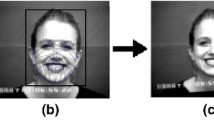Abstract
This paper presents an automatic facial expression recognition (FER) system. The method proposed is based on an adapted gradient local phase quantization (LPQ) descriptor. Two methods for the quantization of the local phase are proposed here to improve the conventional LPQ. These methods are the “phase thresholding” and the “phase LTP coding”. An experimental study of these methods is performed for identification of both the six and seven basic expressions: happy, surprised, fear, disgust, sad, anger and neutral state. The FER system consists of three main stages. The first step consists of the detection of the face, selection of a region of interest, and normalization of this region. Then extraction of features is done by the adapted gradient LPQ method. The third step is the classification of the emotional states. The SVM are used for this purpose. Evaluation of the system performance is done on the well-known JAFFE, and Cohn and Kanade, databases, with both six and seven facial expressions.






Similar content being viewed by others
References
Abbo AA, Jeanne V, Ouwerkerk M, Shan C, Braspenning R, Ganesh A, Corporaal H (2008) “Mapping facial expression recognition algorithms on a low-power Smart camera,” 2nd ACM/IEEE International Conference on Distributed Smart Cameras, Stanford, CA, USA, 7–11
Ahonen T, Hadid A, Pietikäinen M (2004) “Face Recognition with Local Binary Patterns,” In Pajdla T., Matas J. Eds., Computer Vision ECCV. Lecture Notes in Computer Science, vol.3021, Springer, Berlin, Heidelberg
D. Arumugan, S. Purushothaman, emotion classification using facial expression, Int J Adv Comput Sci Appl, vol. 2, n° 7, pp.92–98, 2011
Bartlett MS, Hager JC, Ekman P, Sejnowski TJ (1999) Measuring facial expressions by computer image analysis. Psychophysiol Cambridge Univ USA 36:253–263
T. F. Cootes, G. J. Edwards and C. J. Taylor, “Active appearance models,” IEEE Trans Patt Anal Mach, vol.23, n° 6, 681–685, 2001
Ekman P (1994) Strong evidence of universals in facial expressions: a reply to Russell’s mistaken critique. Psychol Bull:268–287
Ekman P, Friesen WV (1978) Facial action coding system: investigator’s guide. Consulting Psychologists Press, Palo Alto
Heikkila J, Ojansivu V, Rahtu E (2010) Improved blur insensitivity for decorrelated local phase quantization, Proc. 20th International Conference on Pattern Recognition (ICPR), pp.818–821, Istanbul, Turkey
Holder R, Tapamo J (2017) J Image Video Proc 2017:42. https://doi.org/10.1186/s13640-017-0190-5
Kanade T, Cohn JF, Tian Y (2000) “Comprehensive Database for Facial Expression Analysis,” In Proc. IEEE International Conference on Automatic Face & Gesture Recognition, 46–53
Shaik Taj Mahaboob, S. Narayana Reddy, “Comparative performance analysis of LBP and LTP based facial expression recognition,” Int J Appl Eng Res, vol.12, n°17, pp.6897–6900, 2017
Naik N, Rathna GN (2014) “Real time face detection on GPU using opencl,” Computer Science and Information Tech. (CS & IT), 441–448
Nguyen H-T (2014) Contributions to facial feature extraction for Face recognition", PhD thesis , GIPSA Laboratory, University of Grenoble, France
Ojansivu V, Heikkilä J (2008) Blur insensitive texture classification using local phase quantization. In: Elmoataz A, Lezoray O, Nouboud F, Mammass D (eds) Image and signal processing, ICISP 2008, lecture notes in computer science, vol 5099. Springer, Berlin
Pantic M, Rothkrantz LJM (2000) Expert Ststem for automatic analysis of Facilal expressions. Image Vis Comput 18:881–905
Rowley H, Baluja S, Kanade T (1995) “Human face detection in visual scenes,” Technical Report CMU-CS-95-158R, School of Computer Science, Carnegie Mellon University
Sung KK, Poggio T (1994) “Example-based learning for view-based human face detection,” Technical Report A.I. Memo 1521, CBCL Paper 112, MIT
Tan X, Triggs B (2010) Enhanced local texture feature sets for face recognition under difficult lighting conditions. IEEE Trans Image Process 19:1635–1650
Vapnik VN (1998) Statistical learning theory. Wiley, New York
P. Viola and M. Jones (2001) “Robust Real Time Object Detection,“Second International Workshop on Statistical and Computational Theories of Vision Modelling Learning Computing and Sampling, Vancouver, Canada
Viola P, Jones MJ (2001) “Rapid object detection using a boosted Cascade of simple features,” proceedings of IEEE computer society Conf. On computer vision and. Pattern Recogn 1:511–518
Chenggang Yan, Yongdong Zhang, Jizheng Xu, Feng Dai, Jun Zhang, Qionghai Dai, and Feng Wu, “Efficient parallel framework for HEVC motion estimation on many-Core processors,” IEEE Trans Circ Syst Video Tech, vol.24, N°.12, pp.2077–2089, 2014
Zhang Z (1999) Feature-based facial expression recognition: sensitivity analysis and experiments with a multi-layer perceptron. Int J Pattern Recognit Artif Intell 13(6):893–911
Author information
Authors and Affiliations
Corresponding author
Additional information
Publisher’s Note
Springer Nature remains neutral with regard to jurisdictional claims in published maps and institutional affiliations.
Rights and permissions
About this article
Cite this article
Kherchaoui, S., Houacine, A. Facial expression identification using gradient local phase. Multimed Tools Appl 78, 16843–16859 (2019). https://doi.org/10.1007/s11042-018-7069-z
Received:
Revised:
Accepted:
Published:
Issue Date:
DOI: https://doi.org/10.1007/s11042-018-7069-z




